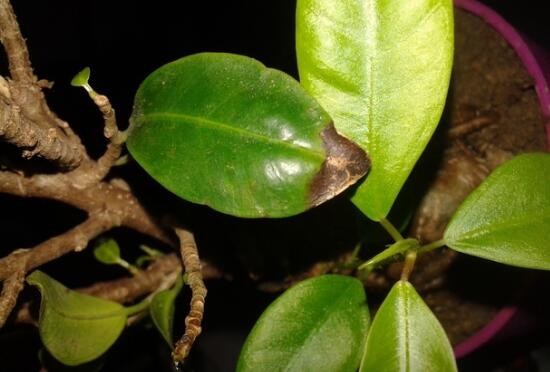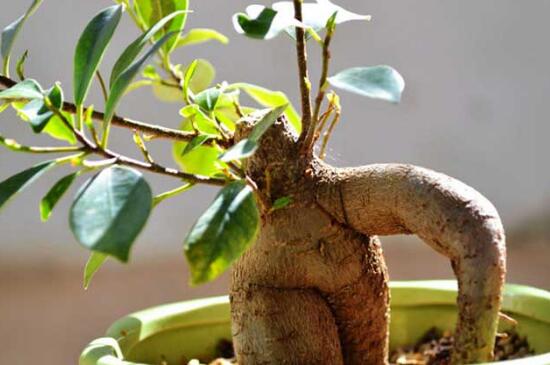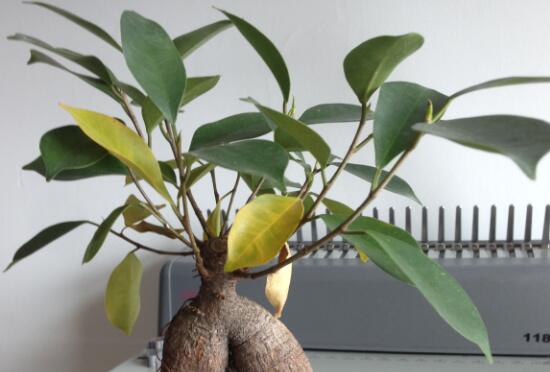Ginseng banyan leaves black how to do, add light / proper watering / pay attention to keep warm in winter
As a common ornamental plant, ginseng fig is kept indoors by many people because of its peculiar root shape and luxuriant foliage. Logically speaking, ginseng fig adaptability is strong, is very easy to raise. But in the breeding process, many flower friends of ginseng fig leaves will appear black situation, that ginseng fig leaves black how to do? Today's editor will solve this problem for everyone.
1. Ginseng fig leaves are black, find out the reason

Among the many indoor potted plants, the cultivation method of ginseng fig is not difficult, but because most novices, they will raise the leaves black, thus seriously affecting the ornamental nature of the plant. As for ginseng fig leaves blackened from how to do, in fact, there are many reasons, this time we need to find the cause in time, and then for the solution, the specific we continue to look down.
2. Causes and solutions of ginseng fig leaves blackening
1, improper lighting
① Insufficient light: Ginseng fig likes light, and sufficient light can make it grow more luxuriantly. If it is placed indoors in the dark for a long time, its leaves will appear black due to insufficient photosynthesis.
Solution: Very simple, move it indoor semi-shade, and put it in the sun under the sun.
② Too strong light: In the process of growth, although ginseng fig needs sufficient light, it can avoid strong light. If it is directly exposed to strong light in the sun, its leaves may also appear black.
Solution: immediately move ginseng fig to indoor semi-shade, and then add water, it will not be long, it will restore health.
2. Too much watering
Ginseng fig likes moist environment, usually need us to water frequently, keep basin soil moist. However, watering should not be too much, otherwise it will lead to ponding in the basin, which will make the plant absorb no oxygen, but also isolate the plant's nutrient absorption, after a long time, the leaves of the plant will definitely turn black.
Solution: Daily watering, must be scientific and reasonable, not too much one-time water. If the ginseng fig leaves are black, first observe whether the roots are rotten, if not, put it in a ventilated place to let the water quickly lose; if the roots have rotted, you still need to cut off the rotten roots, and then soak in disinfectant before planting again.
3, the temperature is too low
Ginseng fig is not cold-resistant plants, in winter maintenance must pay attention to heat preservation, it is best to move it to indoor maintenance, and indoor control above 10℃. Otherwise, once the growth temperature of ginseng fig is lower than 6℃, it is easy to be frozen. After freezing, its leaves are likely to turn black.
Solution: When leaves and even branches are found to be frostbitten, everyone needs to cut off all frostbitten parts, then spray disinfectant and return them to warm and sunny environments indoors for maintenance. If the roots are frostbitten, the plant is basically hopeless, so don't waste your time.
4. Diseases and pests
In addition to the above points, there is another reason for the blackening of ginseng fig leaves, that is, it has been invaded by pests and diseases. For example, ginseng fig suffering from brown spot disease, leaves will appear round or oval spots, showing purple-brown late into black, serious words even yellow leaves fall off.
Solution: In addition to brown spot disease, ginseng fig is attacked by insects, leaves may also be black. Therefore, once found, should immediately spray control, as for what medicine to spray, in ginseng fig pests and diseases have detailed introduction, here is not much.
In general, ginseng fig is a plant with strong adaptability. As long as you take care of it carefully, it will grow very good-looking. However, if everyone is careless about maintenance, for a long time, there will also be symptoms such as yellowing of ginseng fig leaves, blackening of ginseng fig leaves, falling of ginseng fig leaves, etc., so when everyone is in maintenance, we must be careful!
How to raise ginseng fig, ginseng fig cultivation methods and precautions/light to be sufficient
Ginseng fig, a very beautiful indoor potted plant, its roots developed, roots often bulge out of the ground, the shape of the strange, deeply loved by flower friends. Life, many people want to raise ginseng fig, that ginseng fig how to raise it? In this regard, Xiao Bian carefully sorted out the family breeding method of ginseng fig, very detailed, friends who want to raise must see oh ~
1. How to raise ginseng fig and understand habits
Ginseng fig likes warm, humid, sunny environment, it is resistant to semi-shade, but not cold-resistant, in indoor cultivation, it should be placed in semi-shade maintenance, usually watered more, keep the pot soil moist, and in winter do a good job of warm measures. As for the cultivation soil, it is best to use a slightly acidic soil that is loose, fertile, well drained and rich in organic matter. So how to raise ginseng fig, very simple, to meet its growth habits.
2. Cultivation methods and precautions of ginseng fig
1. Basin soil
How to raise ginseng fig, first of all should choose basin soil. The reason for this is that many flower friends 'ginseng figs are existing potted plants bought from flower shops or online. Normal maintenance can ensure the growth of plants. However, the flowerpot and soil were very cheap. If he wanted ginseng and fig trees to grow well, he had better choose again.
Flower pot: If it is a family potted plant, choose a small pot, 20cm-30cm high and 15cm-20cm wide. Soil: Root ginseng fig growth habits, the best choice of loose fertile, good drainage, rich in organic matter slightly acidic sandy loam.
2. Light
As a green plant, ginseng fig still has a great demand for light, so light is an extremely critical link in the cultivation methods and precautions of ginseng fig. Because ginseng banyan likes light, and bear half shade, had better put it on windowsill, table a few place decorate so.
Note: to ginseng fig long health, need to let it bask in the sun, of course, when the light is strong, need shade.
3. Temperature
How to raise ginseng fig, proper adjustment of temperature is also necessary. Ginseng fig likes warm living environment, the most suitable growth temperature is 18-33℃, to grow it well, it is best to keep this room temperature.
Note: Ginseng fig is not resistant to high temperature, in the summer is very hot, pay attention to sun protection; at the same time, ginseng fig is not cold-resistant, in winter to pay attention to antifreeze, it is best to let the room temperature not lower than 10℃, if lower than 6℃, it will lead to plant wilt or even death.
4. Watering
Water is the source of life, so watering is an essential part of growing ginseng and fig trees. Ginseng fig likes wet environment, but it bogeys water, so when watering, to control the watering frequency and watering amount, it is best to abide by the "see dry see wet" watering principle, keep the pot soil often wet can be.
5. Fertilization
After watering, let's talk about fertilization. It is also very important in the cultivation method of ginseng fig. In order to promote the growth of ginseng fig, in its growing season, it should be fertilized once a month, mainly phosphorus and potassium fertilizers, and they can be buried near the roots of plants.
6. Change the basin
For ginseng fig to grow quickly, it is necessary to change pots at the right time. However, everyone should not change the basin too frequently. Generally speaking, one or two years can change the basin. For pots can be carried out in the spring, when adding soil, it is best to properly add base fertilizer, which is beneficial to the growth of the coming year.
7, pruning
With the increase of cultivation time, ginseng fig will slowly grow up, at this time in order to maintain a good tree shape, we also need to give it timely pruning. In spring and autumn every year, thin and diseased branches of the plants are pruned to increase branch growth and improve the ornamental value of ginseng fig.
Ficus species of fig tree
Banyan bonsai unique shape, with high ornamental value. In the household plant bonsai, banyan bonsai because of its evergreen characteristics are more popular with people. Banyan bonsai good to raise it? We raised banyan bonsai for the first time in such a question, afraid that the survival rate of breeding is not high. After all, he had invested his heart and soul into it. Fortunately, at that time, I consulted many methods and precautions for breeding banyan bonsai, and successfully cultivated the first banyan bonsai belonging to my life. In general, cultivation of banyan bonsai is a simple matter, as long as the growth habits of banyan bonsai to culture, survival rate is very high! How to raise banyan bonsai? Let's take a look below.
Banyan tree
Banyan tree. Scientific name, mulberry tree, evergreen tree. Banyan tree can be divided into green tree, banyan pile bonsai, banyan melon (sweet potato fig, ginseng fig) bonsai according to its use. Due to the well-developed roots of banyan trees, the roots often bulge and protrude from the ground. Because of its unique shape, Zhangzhou people have a special liking for banyan trees. The scientific cultivation of banyan tree by plant physiology can make the root grow faster, control the growth height of its branches, cultivate different specifications, different styles and different shapes of bonsai, and have the cultivation method of natural carving and art processing. For banyan bonsai ornamental value enhancement, and become zhangzhou after narcissus another unique flower. From the smallest 50 grams of miniature fig to 2000 grams of different specifications of bonsai. Ginseng fig with natural shape, exposed root plate, beautiful crown and unique charm is interesting and pleasant. Suitable for home furnishings, offices and public places. In recent years, it has been popular in Europe, the United States, Japan, South Korea and other countries and regions, and has been favored by consumers. Is the company's main export products, occupy a larger share of the bonsai market, is a high-end fashion flowers.
How to grow banyan trees
1. Pot soil: Banyan bonsai is different from ordinary delicate indoor plants. It is tenacious and has low requirements for soil. Choose general soil for cultivation, conditional children's shoes, can also choose sandy soil mixed with coal slag.
2. Light: Banyan trees are sun-loving plants. No light will drop yellow leaves, if long-term in the dark, no light, easy to cause bonsai off yellow leaves, serious words directly cause plant death. Children's shoes for breeding banyan bonsai can place banyan bonsai in sunny, ventilated places. One thing must be noted, although the banyan tree is a sunny plant, but the sunshine situation also needs to be adjusted according to the season, the summer sun is strong, should be properly avoided the sun, in order to ensure the normal growth of the banyan bonsai.
3. Temperature: banyan belongs to southern plants, want banyan bonsai healthy growth, to ensure that banyan growth temperature difference can not be too large, when the temperature difference of 10 degrees is easy to cause banyan leaves or even death. When the temperature is about 5℃, move indoor sunny warm place to keep warm, in case of freezing. Winter basin soil should be dry. In late autumn and early winter, when the lowest temperature at night drops to 6--7℃, it should be moved indoors to overwinter in the sun, and the room temperature in winter should not be lower than 5℃.
4. Watering: Banyan bonsai because it is a choice of shallow pot planting, to avoid excessive watering caused by stagnant water caused by banyan roots rot. Generally, watering can be carried out according to the principle of "seeing dry and seeing wet". Pot soil selection sandy soil children's shoes, in watering can be appropriate to pour more water, sandy soil permeability is higher than viscous soil, so choose viscous soil children's shoes, in watering to avoid pouring too much water, water is easy to cause banyan bonsai root rot. Watering method: first spray water from the leaves, then thoroughly irrigate the roots to avoid the phenomenon of watering semi-dry, that is, the basin surface is dry, and the basin is dry. Water the bonsai properly in summer and less in winter.
5. Fertilization: The demand for fertilizer in different periods of banyan growth is different. Summer and autumn are the growth periods of banyan trees, which require more nutrients. It is recommended to fertilize once a month. Adopt decomposed cake fertilizer water. Less fertilizer can be applied in winter. It's okay not to fertilize. When fertilizing, pay attention to burying fertilizer into the soil along the edge of the flowerpot, and water immediately after fertilization. The main components of fertilizer are nitrogen, phosphorus and potassium.
6. Pruning: banyan bonsai resistant to pruning. If you want a beautiful banyan bonsai, you should prune it in due time. The most suitable season for pruning is early spring. In the process of maintenance, you can also prune the new branches properly. Trim it according to the shape you like. It can greatly enhance its ornamental value.
7. Change pots: every two years to the banyan bonsai for a pot to change the soil. When changing pots, the organic fertilizer will be crushed and decomposed according to a certain proportion, mixed into the pot, slowly providing nutrition. It is best to change pots in the early spring or late autumn of the banyan dormant period, while thinning the roots that are too dense. (It should be in April or May.)
8. Pest control: 1. If the banyan bonsai is placed in a stuffy and unventilated place, it is easy to suffer from scale insect disease and should be prevented and controlled in time. It can be removed manually with a brush. 2. The roots of banyan trees are also prone to root rot or nodule disease caused by various bacteria and fungi. Usually, under the condition of not damaging the roots, the soil should be slowly opened to check the roots, and appropriate attention should be paid to spraying for prevention and control.
Through the above introduction, everyone knows about the cultivation methods of banyan trees, right? It is still relatively simple and easy to raise bonsai. What are you waiting for when you have just finished decoration? Just raise a pot. If you are interested, please pay attention to other contents.
- Prev

How to raise ginseng banyan, how to cultivate ginseng banyan and matters needing attention / sufficient light
Ginseng banyan, a very beautiful indoor potted plant, has well-developed roots, the roots often protrude from the ground, and is deeply loved by flower friends for its peculiar shape. In life, many people want to raise ginseng banyan, that person ginseng banyan how to raise? In this regard, the editor carefully sorted out the family culture methods of ginseng banyan, which is very detailed.
- Next

What if the leaves of ginseng and banyan turn yellow, proper light / reasonable water and fertilizer / spraying with medicine in case of insect pests
Ginseng banyan, named because its roots are shaped like ginseng, is a kind of ornamental plant suitable for indoor culture. It has different shapes and luxuriant leaves, and is deeply loved by flower friends. However, in indoor farming, many flower friends will encounter the problem of ginseng banyan leaves yellowing, so how to do ginseng banyan leaves yellowing? To this
Related
- Fuxing push coffee new agricultural production and marketing class: lack of small-scale processing plants
- Jujube rice field leisure farm deep ploughing Yilan for five years to create a space for organic food and play
- Nongyu Farm-A trial of organic papaya for brave women with advanced technology
- Four points for attention in the prevention and control of diseases and insect pests of edible fungi
- How to add nutrient solution to Edible Fungi
- Is there any good way to control edible fungus mites?
- Open Inoculation Technology of Edible Fungi
- Is there any clever way to use fertilizer for edible fungus in winter?
- What agents are used to kill the pathogens of edible fungi in the mushroom shed?
- Rapid drying of Edible Fungi

